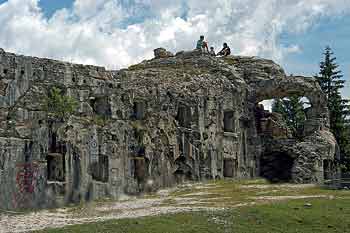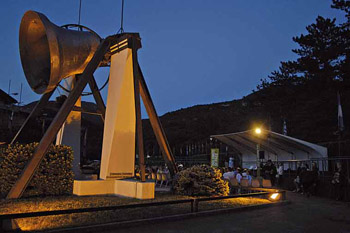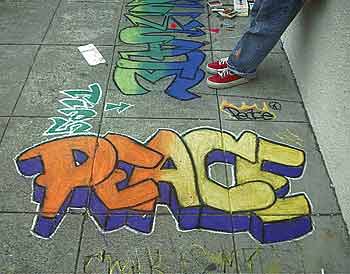

Forte Busa Verle
foto Giovanni Cavulli

Erri de Luca Rifugio Caré Alto
foto Ronny Kiaulehn

Dolomiti di Pace a Forte Dossaccio
foto Ronny Kiaulehn

Rovereto Campana dei caduti
foto Ronny Kiaulehn

|
|
THE ECHO OF PEACE
by Mariapia Ciaghi
“To dream the sweet dream of peace”: who can claim that they do not, or have never fostered this desire, so eloquently expressed by Kant? Not one of us, I believe, even those who are convinced that this dream can only be realised by using instruments of war.
Yet peace remains little more than a “dream”, a “Utopia” without time or place. Our reality is one of wars, conflict and violence which themselves “dream” of being the last, and claim to be the painful but inevitable process necessary to establish a lasting peace, which, in reality, is never achieved. But is it really impossible to intercede between dream and reality, so that the latter comes to resemble the former? Is there truly no alternative to the rude awakening from the dream, and the start of another nightmare? Perhaps some slender space exists, a fragile opportunity between the illusion of the dream and tragic reality: the precarious environment of the imagination, not the oneiric fantasy but the force of thought, the capacity to envisage realities that, although invisible, we know exist, despite all evidence to the contrary: “If we have to imagine peace”, wrote the French philosopher Paul Ricoeur, “it is because war is a blinding reality”. Indeed, “today, peace appears to be severely threatened: a vision of the spirit, perhaps even a hallucination, like a translucent film, a volatile perfume, a bee’s wing, the dream of a wise man who imagines he is a butterfly, or the butterfly which imagines itself wise”, says Julia Kristeva. Indeed, for this writer and psychoanalyst, even “thinking about peace” represents a problem, because “a discussion about life is beyond us at the beginning of this third millennium… Much more than the ‘clash of cultures,’ the failures of modern civilisation lie in our inability to answer the question: ‘what is a life?’ what does it mean ‘to love life’?” She concludes that, “rather than a peaceful co-existence between religions, our salvation lies in a radical analysis of the way in which they view life”. In this sense it is fundamental that we ask ourselves how it is (and the phenomenon is so widespread on both a historical and a geographical level that the fact that it is an anthropological constant, regardless of the specific nature of the protagonists, cannot be denied) that religion, i.e. the set of beliefs, rules of behaviour, sentiments and rituals that man uses to communicate with his god, should inspire warlike rather than peaceful thoughts and actions? Within the divine, are we not used to associating the human yearning for a full life in which peace, justice, prosperity, health, absence of pain, joy, and friendship find their source and their culmination? Perhaps the fundamental reason is to be found in the overwhelming sense of “identity” and the presumption of the “truth” that are inherent to religions. In fact, on one hand, the capacity of religions to determine, define and identify a people, a nation, a family or even an individual forms the perfect “cement” and enables man to exceed his own limits, both for good and for evil: such is the religion that makes me believe it is worthwhile to lay down my life that others might live, but can be so distorted that it provides me with a justification to lay down my life that others might die. On the other hand, the concept of “the truth” is inextricably linked to the identity that religion offers. If we search for this “truth”, scrutinise it, recognise it and accept it as a gift for all mankind, it forms an integral and fundamental part of that “peace” which represents the fulfilment man seeks in his life. But when the “truth” is viewed as an exclusive possession, like a prize to be defended and an idea to be imposed on others, it generates feelings of hostility towards outsiders, and a desire to “rule” ones co-believers. In order to turn back the powerful tides that religions are capable of unleashing, it is essential to analyse the underlying nature of these mechanisms, to convert their aims, or rather restore their original intentions: to fulfil mankind’s potential and re-establish cosmic peace, based on inner harmony, agreement, living together peacefully with all creatures, and shared love. To imagine peace, then, entails freeing oneself from these mental constraints, and granting space for the other to express his identity, his truth: to imagine peace, as Paul Ricouer reminds us, “do not dream it, or hallucinate it, but conceive it, want it and hope for it. In fact, in the final analysis, peace is more than the absence or the interruption of war: it is a positive quality, a state of happiness that consists of the absence of fear and the quiet acceptance of diversity… If I had to create a phrase that distinguishes the imagination of peace from the dream, I would call it the will to tranquillity, in the calm acceptance of diversity on a planetary scale”. How obstinate the perseverance, how tenacious the patience, and how intense the inner struggle required to achieve this “tranquillity”, and which lies before us every day.
|
